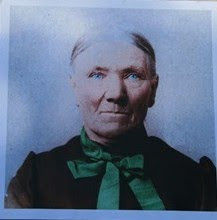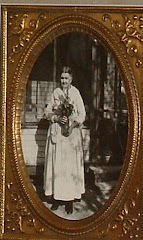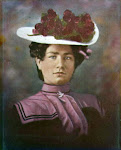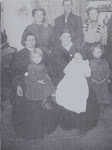 |
| Sarah Goode Marshall |
From Robert Oral and Myrtle Welch Hatch: Their Life Stories, Posterity, and Pioneer Ancestors compiled by Marjorie Eddy and Kathleen Savage Judd, 2004—may be reproduced for family purposes only, not commercial.
Some of the following information came from “Life Sketch of Sarah Goode” written by an unsigned granddaughter. In addition, information has been gathered from “Handcart Companies by William G. Hartley, the Millennial Star, and “Mormon Pioneer Overland Travel” information provided on the lds.org website.
Thomas and Sarah’s Beginnings
Thomas was born on August 28, 1820 to Richard and Margaret Clay Marshall in Linton Hill, Herefordshire, England. We have no other information about his birth or youth. Meanwhile, Sarah Goode, the daughter of George and Selena Mary Ann Holder Goode, was born March 2nd or 4th, 1822 at Abenhall, Gloustershire, England.
As a girl, Sarah learned the art of making kid gloves. She always worked hard; she was famous for saying, “Idleness is the devil’s workshop.” She learned to read and write, but had a limited education. She loved to read the Bible and read it often. She often remarked, “There is something more in the Bible than the ministers understand.”
Mixing Marriage and Religion
Sarah Goode married Thomas Marshall on May 7,1843. Their first daughter, Lovinia, was born March 12, 1844 in Lea, Gloustershire. They then moved to Linton in Herefordshire. Tom and Sarah then had three more of their children: Selina, born February 22, 1846; Tryphena, February 4, 1848; and Louisa, March 12, 1850.
During this early part of their married life, they lived comfortably and happily until Sarah became interested in the Restored Gospel. She often had to walk many miles (with her baby in her arms) to hear the Elders preach. Tom opposed this religion bitterly and would sometimes follow her to the meeting to cause a scene and disturbance. When Sarah did manage to attend alone, she was often impressed by the prompting of the spirit: “Sarah, you had better go. Tom is coming.” She would leave the meeting immediately, but often took a severe whipping from Tom before reaching home.
In spite of the persecution, she was baptized on August 22, 1851 at Edge Hills by Joel Arkwell and confirmed August 25 by Joel Arkwell (verified in Linton Branch records 1840 1865, film #0087011, item #10).
The next year, Sarah gave birth to George Thomas on November 9, 1952. Even with a new child, the family was not at peace. Sarah continued to live under difficult conditions until the summer of 1853. She had wanted to travel to Zion, but she knew that Tom would oppose it. She told her grandchildren later, “I was so anxious to come to Zion that in my prayers I would ask my Heavenly Father to remove the stumbling blocks from my pathway. Little did I think he would remove them by the death of my husband. I was hopeful that Tom would embrace the Gospel with me.”
We do not understand all of the circumstances surrounding Tom’s life or his anger against this new religion, but there may have been some unknown struggles that led him to commit suicide on July 10, 1853. His death certificate recorded that he was a laborer and that he died in the Linton district.
Tom’s death left Sarah penniless, pregnant, and alone with five small children. Baby Sarah was born January 11, 1854, six months after her father’s death. But Tom’s death did open the way for ten-year-old Lovinia and eight-year-old Selina to be baptized. The girls were baptized on August 13, 1854.
“She Shall Go To Zion”
Now the way for them to join the saints in Zion was open, but it still seemed utterly impossible. She prayed for help in this great undertaking and worked very hard to save money for their immigration. During the day she worked as “lady’s maid” and at night she made gloves; after two years she had saved enough. Lovinia and Selina, ages 11 and 9 respectively, had to help care for the other children.
The night before leaving her native land, Sarah’s relatives and close friends had planned a party to say goodbye. She always lived an honest life and was respected by many. Some of the presiding Elders of the British Mission were invited guests at this party. Unfortunately, the spirit of discouragement spread through the group. Sarah’s friends and family began to gather around her, trying to persuade her to stay, telling her she would lose her children and probably her own life on the way.
One of the Elders overheard the discouraging remarks. He arose to his feet and by the power of God, raising his hands above her head he exclaimed: “I will promise Sister Marshall in the name of Israel’s god that she shall go to Zion and shall not lose one of her children by the way.”
Journey Across the Sea
The following day, Saturday, April 19, 1856, Sarah, her sister Maria Goode, and the children: Lovinia, Selina, Tryphena, Louisa, George, and Sarah boarded the ship S. Curling and sailed from Liverpool, England under the direction of Dan Jones who was returning from a mission to Wales. They were among the 707 British Saints on board.
Notes from that voyage recorded: “As soon as the ship was fairly under way, the usual organizations were effected; several severe storms were encountered, and on several occasions the brethren assembled for prayers and curbed the fury of the winds and waves by the power of the holy priesthood. During the passage six children died, and two were born.” But Sarah and her children were fine, just as the Elder had promised.
“On the twenty third of May the Samuel Curling was towed to quarantine ground, at Boston. In a few hours the inspectors came on board welcomed by the spontaneous three cheers of seven hundred people, ‘and strange as it may seem,’ writes Elder Dan Jones, ‘called the names of all and passed them in less than one hour and a half without any further complaint than that ‘I was taking all the handsome ladies to Utah.’
“‘The passengers were all remarkably clean, as well as the ship, which commanded the admiration of all. In proof of the latter I would say, that I had made a wager with Captain Curling, upon leaving Liverpool, that the lower decks would be whiter than his cabin floors, and the quarantine doctor decided in my favor.’
“On the twenty fourth of May, President Jones contracted with the railroad officials to take about four hundred of the passengers to Iowa City, for $11.00 per adult over 14 years old, children half price. The kindhearted captain allowed the passengers to remain on board the ship till Monday the 26th of May, when the journey was continued to Iowa City” (Millennial Star, Vol XVIII, pages 283, 411, 426, 542; Deseret News, Vol. VI, page 160).
The First Handcart Company
By the mid 1850s, LDS Church leaders were looking for less expensive ways to move poor immigrants to Utah. The Perpetual Emigration Fund that loaned passage and transportation money to the needy was depleted while costs for wagons and ox teams were high. Therefore, Brigham Young announced on October 29, 1855 a handcart system by which the church would provide carts to be pulled by hand across the Mormon Trail. Leaving from Iowa City, the distance to Salt Lake was 1, 300 miles.
Handcarts, assembled at outfitting points in Iowa City and then later in Florence, resembled carts pulled by porters in large cities. The carts had hickory or oak wagon beds and hickory shafts, side pieces, and axles. Wheels were as far apart as normal wagon wheels. Each cart carried 400 to 500 pounds of foodstuffs, bedding, clothing, and cooking utensils, and needed two able bodied people to pull it. Five people were assigned to each cart. Adults could take only seventeen pounds of baggage, and children ten pounds. Families with small children traveled in covered or family carts which had stronger axles made of iron.
Arriving in Iowa, Sarah, age 34; Maria, age 25; and the children, ages 12 down to two did not have the money to purchase a wagon, oxen, supplies, etc. They decided to try this new, less expensive way to travel; they petitioned to join the first handcart company which was being formed. Edmund Ellsworth, a returned missionary from Britain, was designated as captain.
Sarah procured a handcart and asked the captain if she could join with his company in crossing the plains. The company was large, and this was the first attempt in crossing the plains with handcarts. Captain Ellsworth answered, “Sister Marshall, it would be unreasonable for you to expect such a thing. You are a widow with six small children. You would only be a hindrance to the company.”
Her answer was, “Well, Captain Ellsworth, I’m going and I’ll beat you there.”
The Difficult Journey West
The first handcart company under Edmund Ellsworth departed from Iowa City in the late afternoon on June 9, 1856 with 280 people and 52 handcarts. The McArthur handcart company was just a few days behind.
Joining the first handcart company were the Birmingham Brass Band. They only made four miles their first day, and then had to rest two days while lost cattle was found. The next day, two of the handcarts broke down. This was followed by a windy, rainy crossing of Iowa. On July 8th, they arrived at and were ferried across the Missouri River. At Florence they spent 10 days repairing handcarts. Here, 20 Italian saints joined the company. They left Florence on July 20 with 55 handcarts.
Their initial progress had been slow, making seven miles a day. By the time they reached Florence, they were covering 20 miles per day. They crossed the Elkhorn River, the Loup Fork River, and Prairie Creek. The thunderstorms were terrifying and one man was killed by lightning. Once they had to wait an hour for a buffalo herd to cross the road. When the company drank water from a buffalo wallow, diarrhea spread through the camp.
Sarah had not realized how tedious and difficult the journey would be. After traveling a few weeks, food had to be rationed. Only two ounces of flour was allowed for each member of the family a day to exist on, and at night they took turns in using the “bake ovens.” Tents were used at night. 20 people were assigned to each tent.
One night when Sarah was preparing her rations for the next day’s journey, a young man came to her and said, “Will you please give me something to eat? I am starving to death.” She shared what she had with him. Later she recounted, “I have thanked the Lord many times for sharing my food with this young man, for he was found dead in his bed the next morning and should I not have done so, my conscience would have condemned me the rest of my days.”
By mid-August, the handcarts were traveling beside the Platte River. Each night after stopping to camp, Sarah’s first impulse was to look for her children, as they would get scattered among the company during the day’s travel. One night, Sarah was horrified to discover Tryphena, age eight, was missing. Immediately, she reported the situation to Captain Ellsworth and said, “I cannot rest until my child is found.” He asked for volunteers to go back to search. Sarah and some men started out, but after going some distance were forced to return because of hungry wolves circling them.
Sarah returned to camp worried and frantic. As they approached, they heard shouts and to their great joy found Tryphena safe in camp. She had walked with an Italian man during the day. He had lain down for a rest. She stayed with him until it got dark when she realized he had died. She began walking and saw a fire, but she did not know if it was a fire from her camp or Indians. She crawled up and to her relief found it was the handcart company.
After traveling on the north side of the Platte, they forded it at Fort Laramie on August 26. They had to recross it and the North Platte until they reached Deer Creek where they met five supply wagons that had been sent from the Salt Lake Valley to assist them. On September 3rd they crossed the Platte for one last time. The next day it rained and snow, making it impossible for them to start fires. To make matters worse, some cattle had strayed, so they spent another cold day recovering them.
The company reached Devil’s Gate and passed old Fort Seminoe trading post on September 8th. On September 11th, they took the Seminoe Cutoff, a route that tracked south of Rocky Ridge and bypassed four crossings of the Sweetwater River.
On September 18, they forded the Green River. An eastbound group of missionaries saw the company descending the ridge to the river. It was an impressive sight, and they got out of their wagons and formed a line for the oncoming pioneers to pass through, cheering them with a Hosanna shout. The members of the handcart company cheered back so loudly that the hills rang with echoes.
Three days later, the company camped at Fort Bridger. Even through the mountains where they encountered thunderstorms and cold, the company averaged 20 miles a day. Proving their fitness, they climbed up and over Big Mountain in less than three hours. They camped at the foot of Little Mountain, ready to enter the valley the next day.
Sarah and her family were lucky; none of them had died on the trail, but 13 people in the company did die. They endured hardships, hunger, thirst, fatigue, and ceaseless toil, pulling her handcart the entire distance.
The First Handcart to Arrive
The night before entering the valley, Sarah asked the captain if she, Maria, and the children could start out ahead of the company since this would be their last day of travel. Permission was granted and very early the next morning the little family started out. After traveling some distance from the company, they discovered some men on horseback coming in their direction. As the men approached, they started yelling and cheering for the arrival of the handcart. The little family, however, thought they were Indians. Sarah and Maria gathered the frightened children about them.
The horsemen, seeing the family’s mistaken terror, stopped their noise and rode quietly down to them. They were scouts from Salt Lake sent out to meet the handcart Saints, as the settlers in the valley had been anxiously waiting for the arrival of this company.
These men assisted Sarah and Maria by taking the children on their horses to the settlement, leaving the two women free to pull the cart. Sarah, Maria, and her children were the first of this company to arrive in Salt Lake; thus her statement to Captain Ellsworth became a prophecy: “I’m going and I’m going to beat you there.” Family tradition has Sarah being the very first handcart pioneer to enter the Salt Lake Valley, arriving on September 26, 1856.
When the company reached the valley, a welcoming committee including Brigham Young, the other members of the First Presidency, and the Nauvoo Brass Band greeted them. Shortly afterwards, the second handcart company caught up with them. The First Presidency, the band, and the two handcart companies then paraded down into Salt Lake where they were cheered and joined by the local saints.
Captain Ellsworth later stated that though some had questioned the ability of women and children to travel by handcart, the children had walked the whole way, and the women had withstood the rigors of the trail better than men of comparable age.
A Second Marriage
At first Sarah and her children lived in the Salt Lake Fort. Her next home was in Ogden, where she lived for some time at the home of William Wasleigh, known to her in Britain. Sometime at the end of 1856 or early 1857, Sarah married Joseph Chadwick. Their first son William was born October 6, 1857 in Ogden, Utah.
Around this time Tryphena was probably baptized though the first date has been lost. Lovinia married Clinton Bishop in the Endowment House on March 9, 1858.
Sarah and Joseph were among the first settlers in Franklin, Idaho and endured some troubles with the Indians in that area. Unfortunately, Sarah’s worst treatment was from her husband. He was very unkind. Their second son Charles Frederick was born August 6, 1860 in Franklin, Idaho.
Sarah continued to raise the children in her care. She was a great mother. Her children continued to grow in the Gospel. In 1862, George was baptized.
Yet for Sarah, life became unbearable. Robert Gregory reported that she divorced Joseph near the end of 1862. Early in 1863, Selina married Robert Gregory, also of Franklin. Louisa and young Sarah were baptized in October. In November of 1864, Tryphena married Bethuel Hunt.
There is another family story about Sarah, but it implies that she was still married to Joseph in 1865.
On the night of February 23, 1865, Sarah awoke from her sleep startled with howling and barking of dogs. She went outside and distinctly heard cries of help. Rushing into the house, she went to her husband’s room and asked him to get up, that she had heard someone calling for help; but he told her to go back to bed, that it was only wolves howling.
The following morning, teams were sent out to break the snowy road between Franklin and Oxford. They discovered the frozen bodies of John Boice, Jr. and George Barzee—the men Sarah had heard. That May, Louisa married Martin Boice, the dead young man’s brother.
This contradicts Robert Gregory’s own account, stating that Sarah divorced Joseph in 1862, but since this story came from Louisa’s family, perhaps there was a reconciliation between Joseph and Sarah.
Divorced or not, Sarah eventually moved to Dayton, Idaho where Joseph had a small mercantile business. Young Sarah married Peter Pool in the Endowment House on March 14, 1868. And on December 20, 1870, George married Elvira Van Curen in the Endowment House.
Returning home one evening, tired and hungry, Sarah discovered her ax had been stolen. Having great faith, she prayed and asked that she might find the missing tool. A few days later, she and a neighbor were on their way to the river with their water pails when she was prompted to dig at the side of the road. She paid no attention until the third time. She went back. Digging in the earth a few inches, she discovered her ax. She learned some days later that it was Joseph who had taken the ax.
Joseph died in 1876. Sarah’s step-children took the merchandise from the little business, and Sarah suffered a big financial loss, left again in strained circumstances. One of her friends said, “Oh Sister Chadwick, why do you let them rob you?” Sarah replied, “The Lord says, ‘Vengeance is mine, I will repay.’” Her friend’s answer was, “Oh Sister Chadwick, the Lord is so slow.”
Sarah continued to raise her last two sons and provide for them as best she could.
A Widow, Again
Sarah worked hard to survive. After the crops were harvested, the farmers let Sarah glean in their fields, so for a few days she and her children gathered the scattered grain to have flour.
After working in the fields one day, Sarah returned home to discover Indians had ransacked her home, helping themselves to what they could find they left the house. Sarah found everything was topsy-turvy and most of her provisionshad been taken.
Another time, she discovered someone had stolen the buckskins which she kept under her straw tick mattress. She had intended to make her boy a buckskin suit for winter. She was so disappointed that she asked the Lord to bother the thief until he/she could not rest. The next morning Sarah discovered the buckskins stuffed between willows under the shed.
Because of the threat from Indians, it was dangerous to travel the roads alone. As a result, one harvest time Sarah had prepared everything to be ready on short notice to take her grain to the grist mill. Early one morning she saw some men with sacks of grain headed in their wagon for the mill. She wanted to follow closely behind them for safety, so she and her children got her wagon ready just as the men were passing her home. But when the men saw her, they assumed that she was trying to get ahead of them, and they began lashing their oxen.
In their commotion, a sack of wheat slipped off their wagon. Sarah called to them, but they pretended not to hear her. Finally they came to a hill, but their oxen became stubborn and ran off the road into the willows at the foot of the hill. While the men were trying to get them back on the road, Sarah and her oxen went steadily up the grade.
This made the men more upset and two of them ran up the hill with clubs and began to beat their oxen. The man at the flour mill was standing by the mill river (or the mill race) and witnessed the event. When Sarah drove up with her ox-team, he said. “I have seen horse racing, but that is the first ox-team race I ever saw. Those men ought to be ashamed of themselves for treating a widow in such a manner.”
Her last two children by Joseph married: William to Lauretta Neely on November 25, 1879, in the Endowment House; and Charles to Luna Nelson on June 2, 1881, in Franklin. George married again to Mary Jane Alder in 1882 in the Salt Lake Temple.
Trust in Her Heavenly Father
Sarah became a midwife and helped bring many children into the world. Her granddaughter wrote, “She was surrounded with a comforting influence which gave courage and hope to suffering humanity in the hour of distress. She would never allow anybody to say anything about her religion or nationality. She always put her trust in her Heavenly Father, as she was a firm believer in prayer. She suffered many trials, no doubt that accounts for her exceeding faith. Grandmother reached her desired haven here on earth, and no doubt rich blessings await her in eternity. She left a numerous posterity to mourn her departure.”
Sarah Goode Marshall Chadwick died in Dayton on April 26, 1904 and was buried in Franklin, Idaho. At the time of her death, the prophecy of that elder in England the night before her departure had remained true. None of her children had died before her, though Lovinia’s death would occur that December.
Even after her death, her children did not forget her. On May 8, 1912, Selina, Louisa, George, and Sarah met in the Logan Temple and sealed Sarah and Thomas Marshall. Then they had themselves sealed to their parents along with their deceased sister Lovinia and deceased brothers William and Charles Chadwick. Tryphena was alive at the time, but was sealed to her parents after her death.





























